FanDuel's Friends Mode championship
Championship in FanDuel's Friends Mode is a new product that allows Users to compete with friends in a daily fantasy sports (DFS) format over a series of contests. It was designed to accomplish two things: attract Users who normally only play season-long fantasy products to try a daily fantasy offering, and to directly address existing users' feedback about their experience with last year’s existing product. It was launched three weeks before the 2017 NFL season.
In order to comply with my non-disclosure agreement, I have not included any proprietary information or precise research data in this case study.
My Responsibilities
I was the lead UX designer working with two product designers. The product was designed for all platforms.
Ideation
Research: I conducted market research to help shape our feature set. I performed user interviews to gather User sentiments as well as feature requests. I also wrote and analyzed surveys to gather data en masse.
Exploration: I sketched several feature types to determine which had legs and which only looked good on paper.
Scope and Deployment Strategy: I worked with the overall team to help define the MVP feature set for launch.
Iteration
Experimentation: I led 1-on-1 prototype testing sessions to get as many sets of eyes on designs as possible. Recording software was also used to capture user feedback for those located around the country.
Feedback: I collated and curated feedback to the team to help explore how to best address user reactions.
Iteration: I collaborated with my product, design, and engineering teams to ensure that the MVP evolved with each round of feedback yet retain the vital components.
Implementation
Learn through launch: We launched right before the 2017 NFL season, measured user activity and continuously reached out to users to collect their feedback. This way we could collect learnings based on actual user behavior
Establish feature roadmap: By working iteratively towards an MVP launch, then tracking user behavior both quantitatively and qualitatively, we were able to launch a product that our users responded positively to.
The challenge
Bridging the Gap with Season Long Fantasy Sports
According to the Fantasy Sports Trade Association, 56.8 million peopled played in fantasy sports leagues in 2016, spending roughly $18 billion. The DFS industry, however, only has a market penetration of around 5 million users with annual revenue around $300 million. There were two major hurdles that we were tasked with overcoming in order to expand our product's reach. First, negative media coverage colored how mainstream fantasy sports players saw the industry and limited their involvement. Second, state legislatures were deciding whether the product was considered gambling in their jurisdictions, which affected which states we could operate in. We were tasked with making headway into this disparity going into the busiest season of the year, the NFL season.
Iterating on the Previous Product through User Insights
There were several barriers that prevented DFS from experiencing the same market traction that traditional fantasy sports enjoyed. The first barrier was a collective fear of ‘sharks’; many players don’t like to compete in large ‘public’ contests because their sentiment is that only professional fantasy players consistently win those. The second barrier was contests running for free; due to the Unlawful Internet Gambling Enforcement Act (UIGEA), contests couldn't have variable price pools. This meant that if a contest didn't have 100% participation, the remaining players couldn't play for cash prizes. Players consistently cited this as the main experience related barrier they wanted us to improve upon.
With industry trends and User reviews in tow, the two main objectives we had were:
1. Increase the number of players who normally play season long fantasy sports to try our Friends Mode product and play consistently, and
2. Grow revenue by increasing the number of contests that run for money
The vision
Early on, it was clear that our target demographic wasn't satisfied with Pickup, the existing way to play and compete with friends. They asked that whenever they were set to compete, the prize money would always be guaranteed with no contests running prize free. Users also wanted to feel like they were constantly competing with each other over the course of a season, and not just on a week-to-week basis.
To balance user needs with legal restrictions, I worked with the team to create an experience that mimicked their existing behaviors to make the transition easier. The idea was to pre-pay for the league’s season, which meant that money was already set aside for each contest to guarantee that each week would successfully run for cash prizes. We also designed the setup process to give the ‘commissioner’, the user setting it up, additional customizable settings to create a league just for their friends. This included setting the league size, the entry fee, which leaderboard they wanted to track rankings, when they competed each week, how many weeks they wanted to compete for, and how the prize pools were split between the weekly and grand prize.
The hypotheses
Based on the research and early testing that I did, I set out to track two hypotheses which I thought would help us reach our product and business goals for the Championship product.
Hypothesis 1: Users prefer a wizard approach to the free form model of Championship creation.
In order to balance the needs of both returning users and brand new users, I felt that a wizard approach would present the clearest Championship creation model for the largest number of users. I wanted to present as few decisions per step so that people were never overwhelmed with what was asked of them, and would progress quickly through the wizard.
Hypothesis 2: Users want as much customization as possible.
The inherent qualities that make a league setup fun is the customization that it offers the user. I wanted Championship to replicate that experience so that our users felt like they were playing in a league created by them, for them.
Wireframing and initial design
I created and iterated on the initial wireframes which were tested relentlessly to determine which aspects held water and which would find themselves on the cutting room floor.
The final design
After much iteration and testing, the data suggested that a simple wizard approach to the Championship setup would provide enough familiarity to transition our users to this new game type. It was also important to create a base design that would be flexible enough to grow as future product releases expanded the feature set.
It’s important to note here that during development of the Championship product, a merger was announced between FanDuel and DraftKings. Due to legal requirements, the Social team had to halt development for about a month. The loss of three development sprints limited the ultimate feature scope for Championship. Therefore, we pivoted slightly away from a full feature launch and moved towards an MVP+I strategy. This way, we would launch with what we could fit in, and push additional features in fast followup releases.
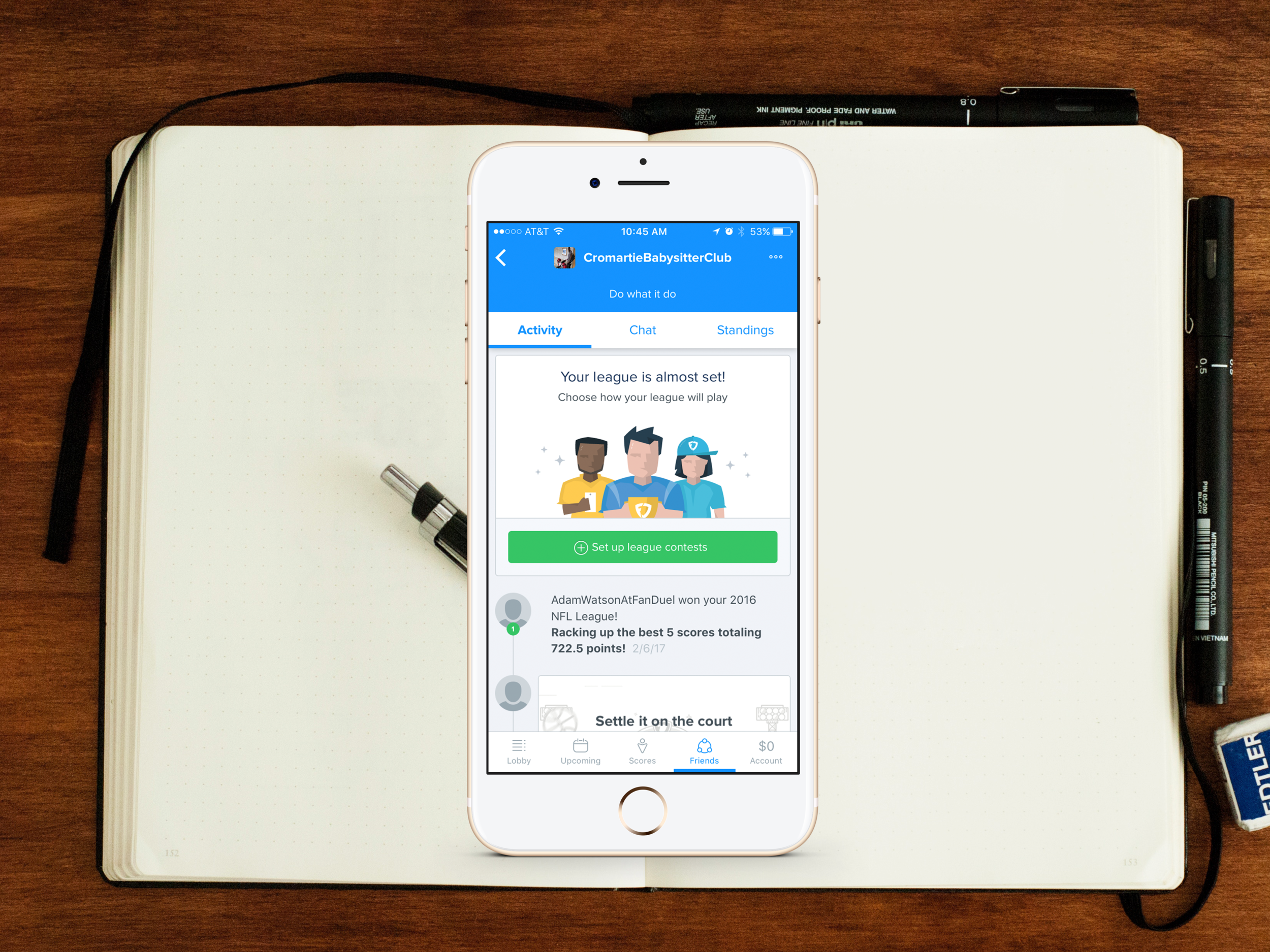
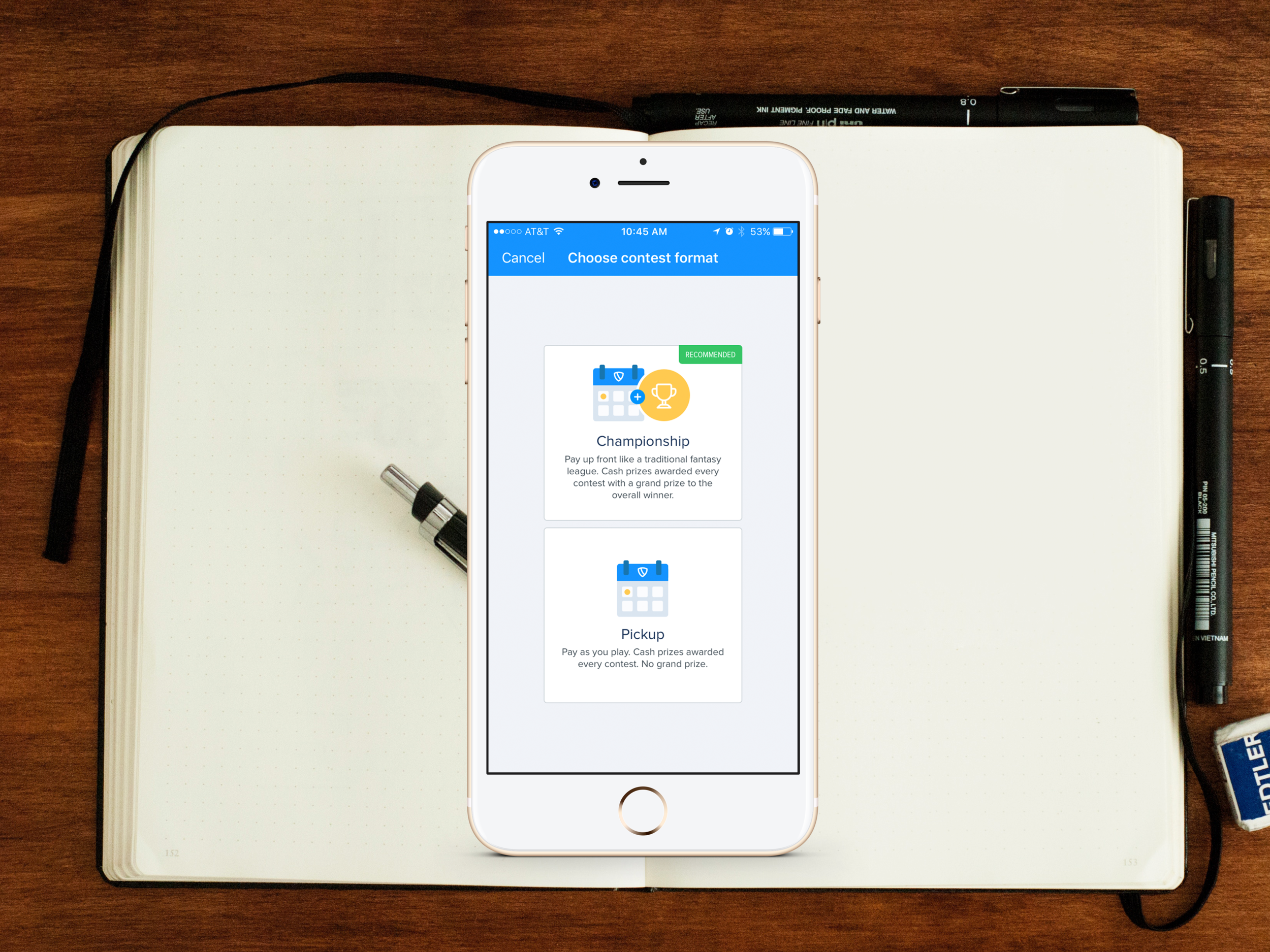
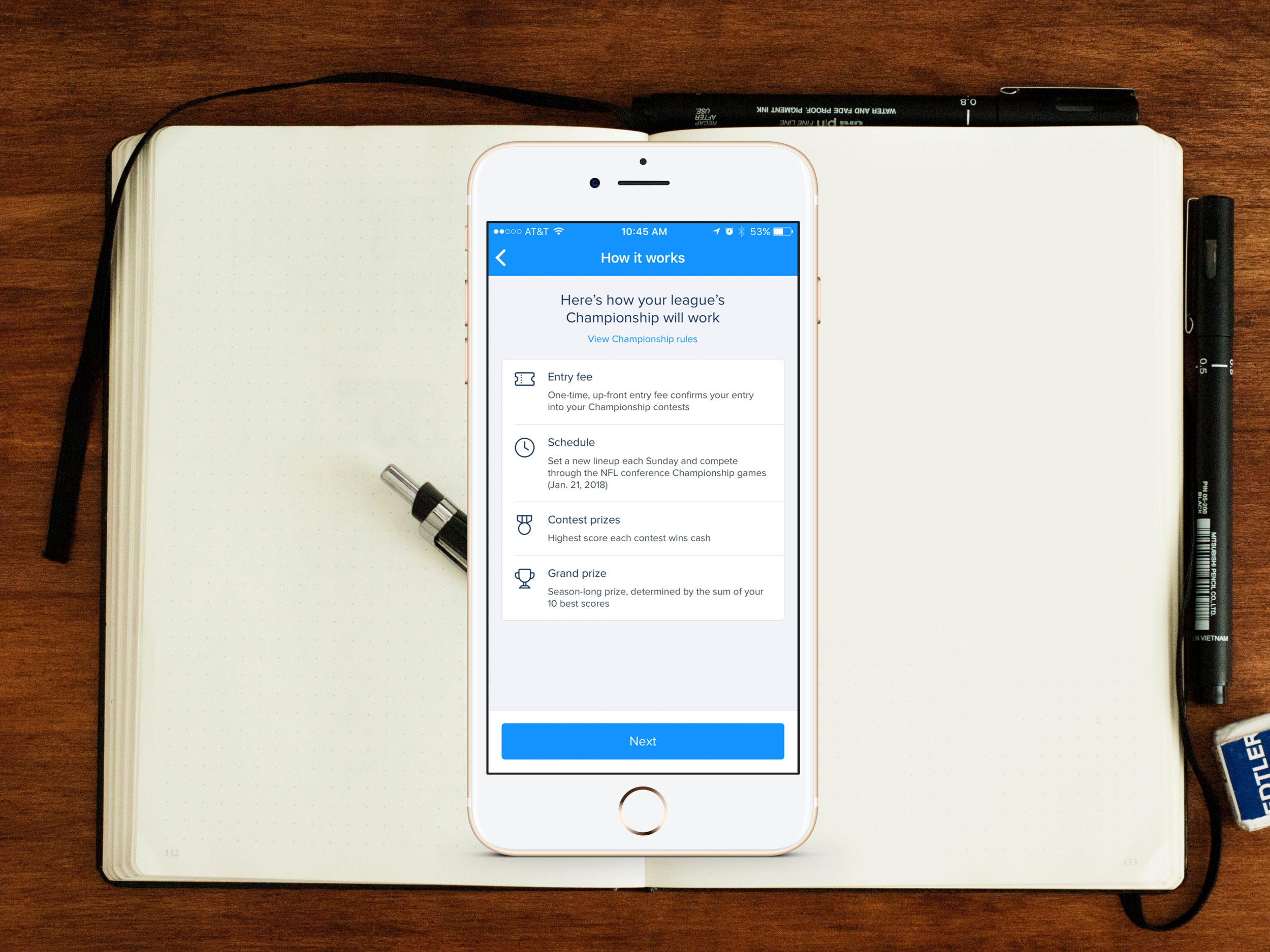
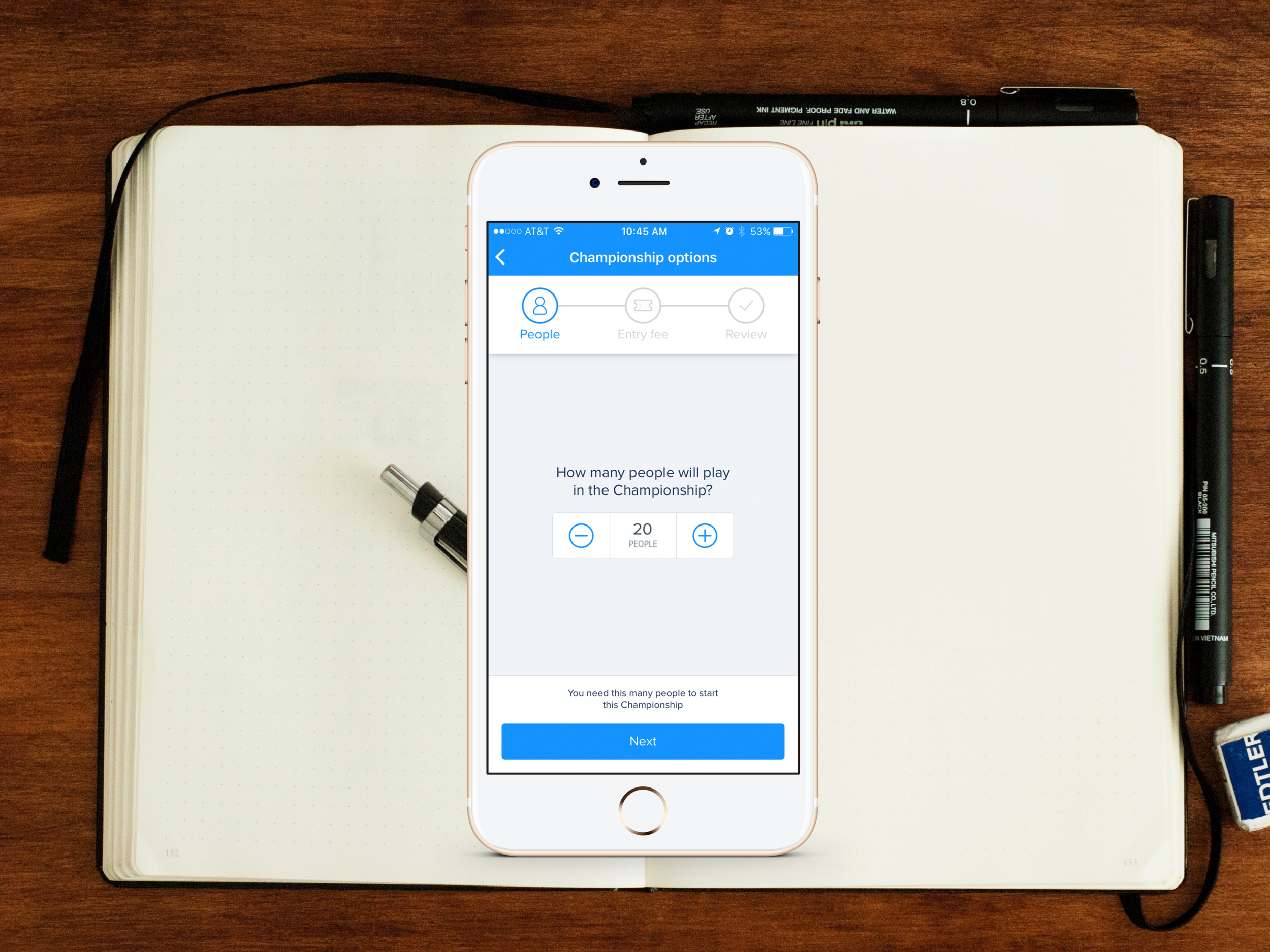
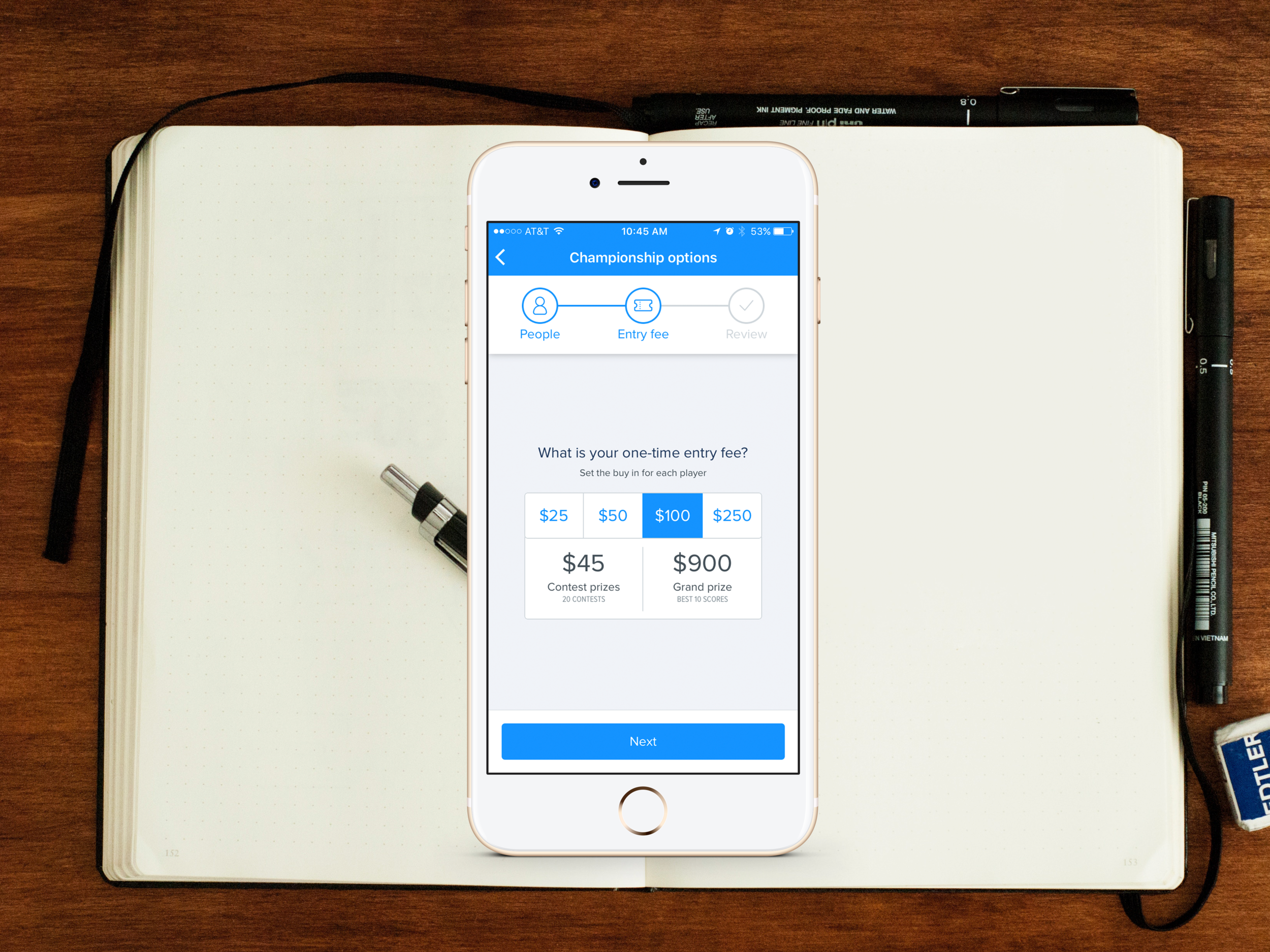

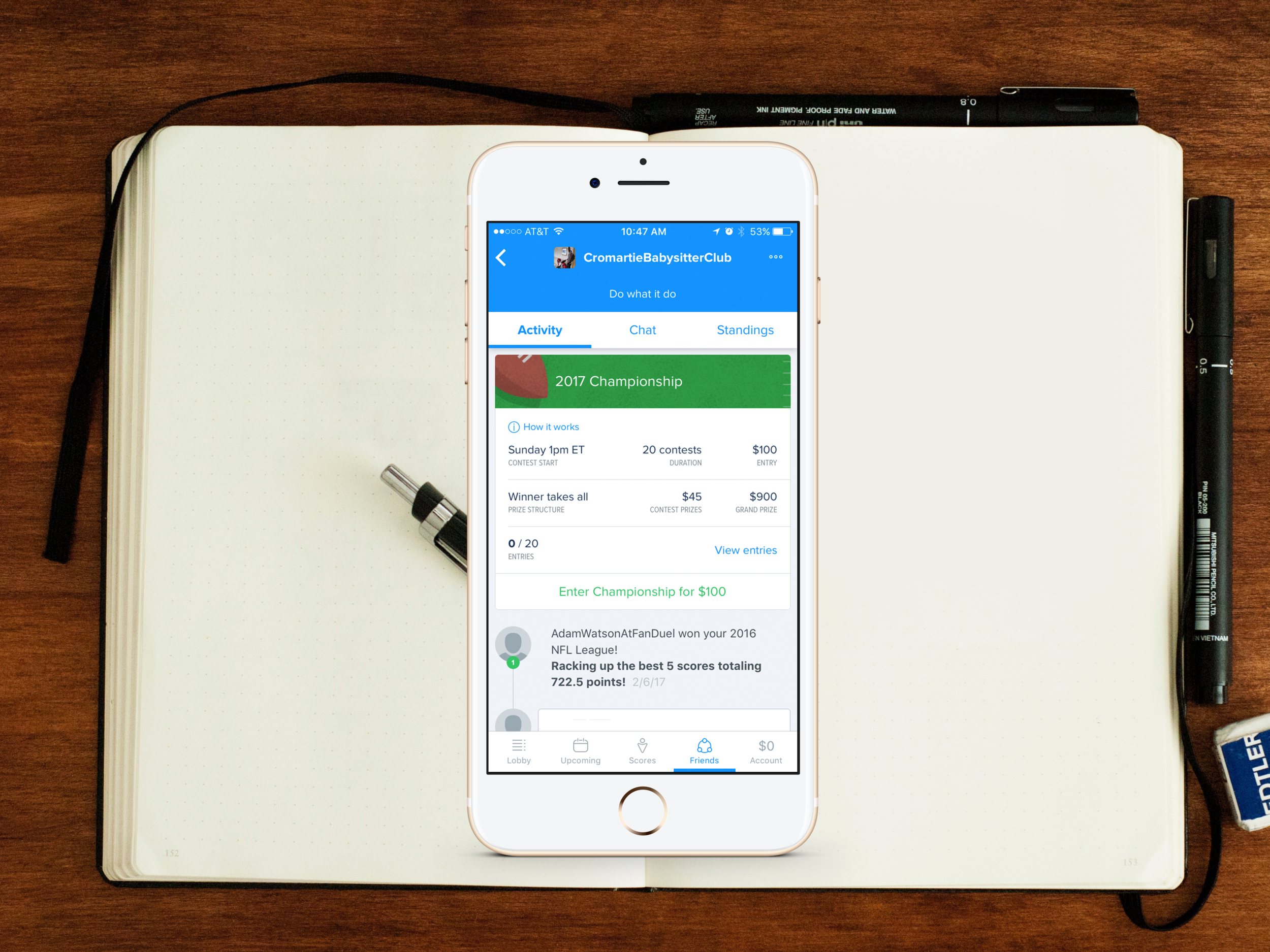
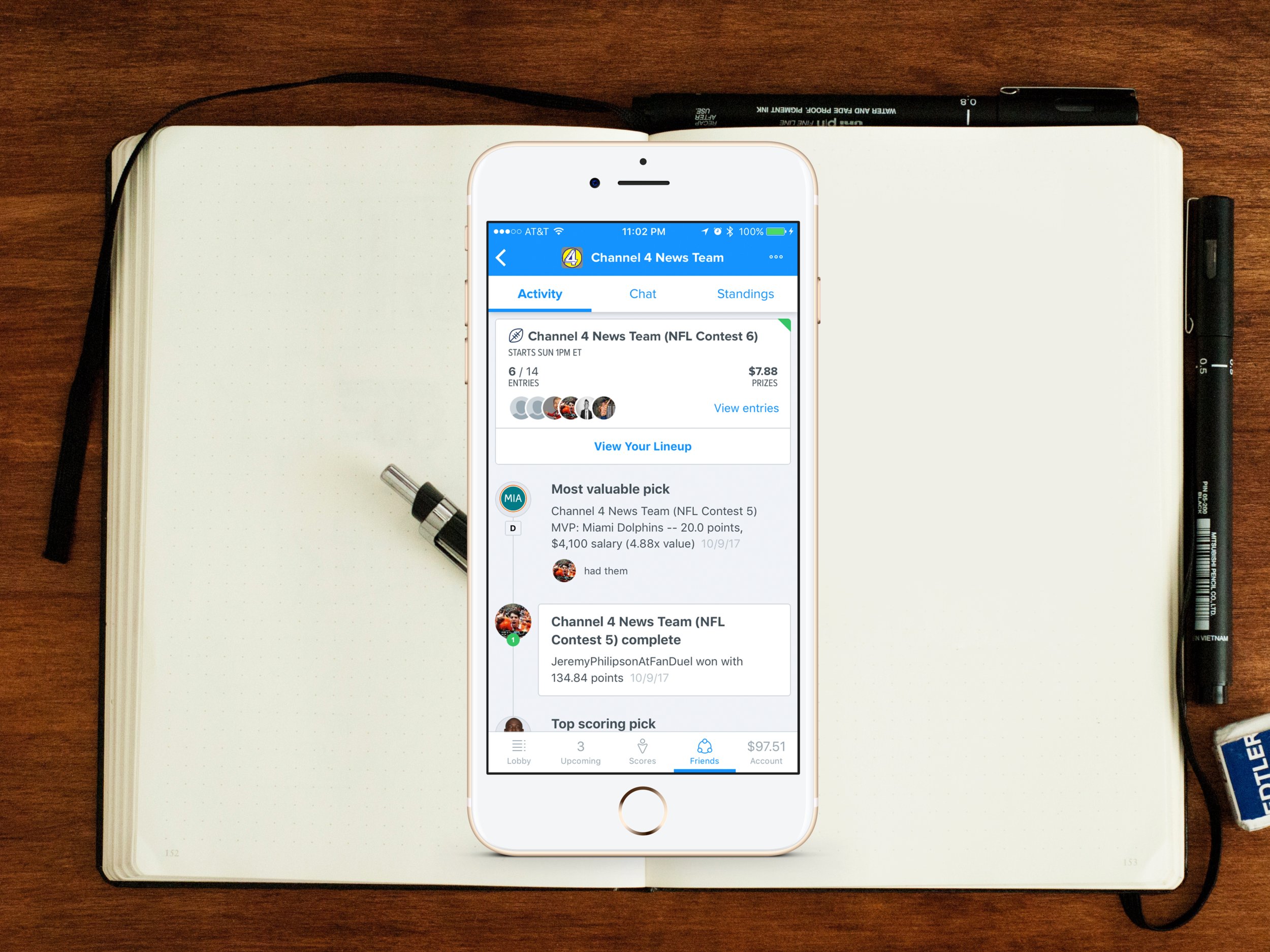
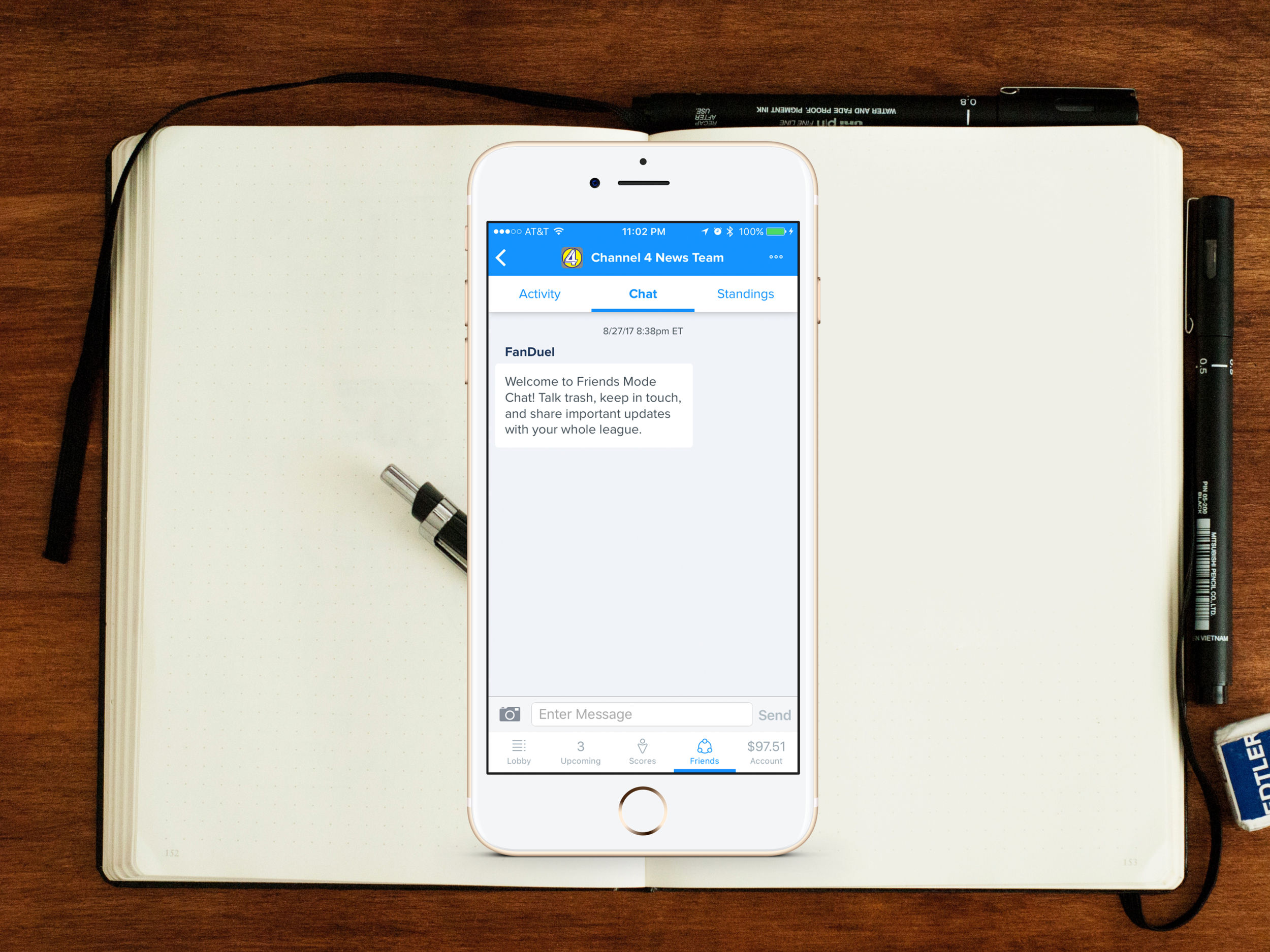
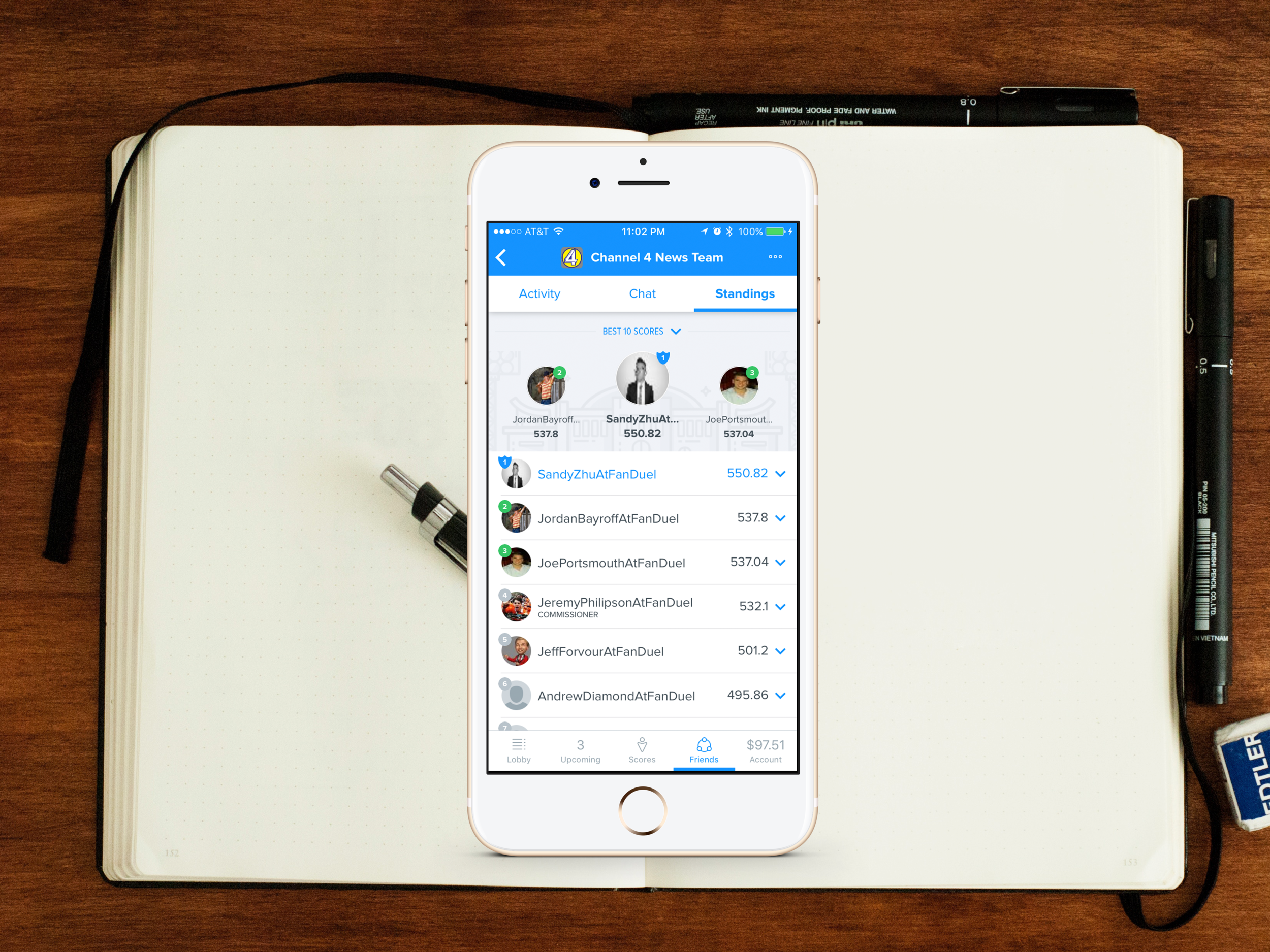
It was important that the Championship card design align with the current design theory of the Social product. This allowed it to remain familiar for returning users, and allow the entire Social product to iterate together moving forward.
In order to market the release, we utilized a layered and diverse communications strategy. We had a TV commercial for broad exposure. We also leveraged an email marketing campaign and an in-app interstitial to notify all existing players of the new release of Championship. The interstitial activated whenever a user opened the Social tab for the first time.
The testing
Upon the initial MVP release, I reached out to dozens of users who we tracked had created Championships. Equally as important, I reached out to users who had started to create a Championship, but then opted out. The following insights were gathered during conversations with our Users.
1. Users felt the Championship wizard was easy to use.
User after User told us that setting up the Championship itself was incredibly simple and straightforward. They appreciated the wizard approach because it presented each task as a simple step. Total completion time was also very short.
"I think I set it up in under 3 min, so you can do this during a coffee break at work; so you don't have to be an engineer or a computer genius to figure this out." - Curtis, Casual User
2. Users wanted true customization of every league setting.
Our initial design decision was to provide Users with a limited set of options to prevent them from feeling overwhelmed. However, our Users stated that the limited options felt constricting, and could potentially be a reason why they wouldn’t proceed with our product.
This led us to explore enhanced customization options for each future product release. With that in mind, it was clear to maintain the current wizard flow since users found it easy to use unless an even simpler wizard could be created. That being said, we were comfortable going to market with the current wizard setup to see how the product would do as the 2017 NFL season kicked off.
The results
From the three weeks leading up to the start of the 2017 NFL season, over 3800 Championship leagues were created, which amounted to a touch under 10% of all total Social leagues created when we factor in existing leagues reactivating. The average Championship league size was around 8-9 people, up from 5 in Pickup leagues. The average entry fee for a Championship league was just under about $60, up dramatically from $5 in last year’s product. We found out that over 90% of Users who created a Championship were returning Users, while organic new acquisitions settled around 8%. Early rounds of NPS scores for Championship tracked at 43, while the existing format, Pickup, tracked at 42.
Unfortunately, while the product tracked very positively with those who tried it, the overall awareness of the product was low. Users who saw it said they were avid DFS players and received the email or in app alert. The more casual player said they missed or don’t recall seeing either the email or the in-app alert.
What did we learn about our two hypotheses:
Hypothesis 1: Users prefer a wizard approach to the free form model of Championship creation.
Users overwhelmingly stated that the process to create a Championship was easy to use, simple, and clear. This was a great confirmation to get. Interestingly, Users stated that they’d also like to be able to do everything on one screen so they didn’t have to go back and forth between steps to remember what they had or hadn’t selected. This was something we tinkered with early, and the feedback was motivation enough to go back and ideate to see if an even lighter experience was possible.
Hypothesis 2: Users want as much customization as possible.
Users liked the product that was launched right before the 2017 NFL season. However, we received consistent feedback regarding the scope of customization, or lack thereof. Users did not like the limited options we launched with; they wanted the agency to input whatever amount they desired, be it the league size, entry fee, etc. This only helped to confirm the feature roadmap as we quickly followed up with feature releases shortly after that started to give Users more customization.
The takeaways
Users who played Championship stated that it solved many of their latent issues with the earlier iteration of the product, Pickup. They especially liked that they only needed to pay once and confirm that all further contests in the Championship were guaranteed to run for cash prizes. While users’ feedback centered on increased customization, this was a good sign since it confirmed our feature roadmap and gave us a clear path forward.
What we could have done better was tailor our marketing campaign more effectively so that a larger group of new users were made aware of this release. Existing Users encountered our messaging relatively effectively
Overall, the Championship product was a success in solving most of our users’ needs when it launched. It also saw promising growth in the number of new users depositing money on FanDuel to experience Championship.








